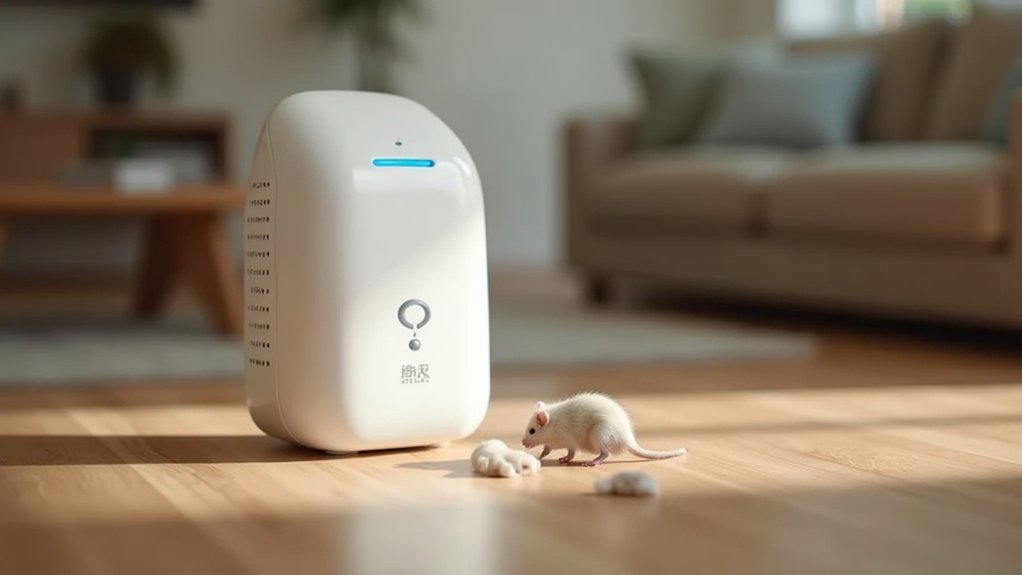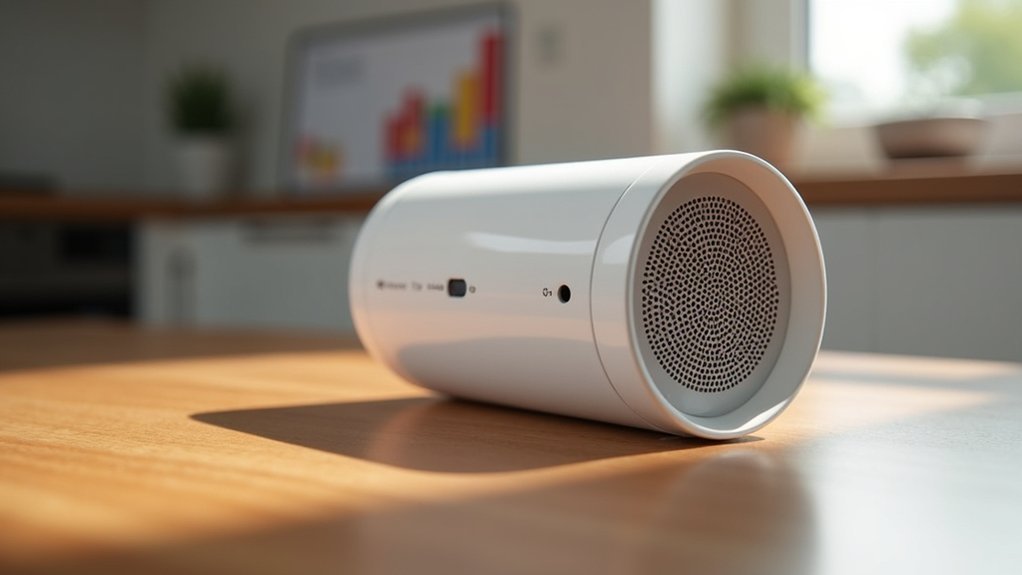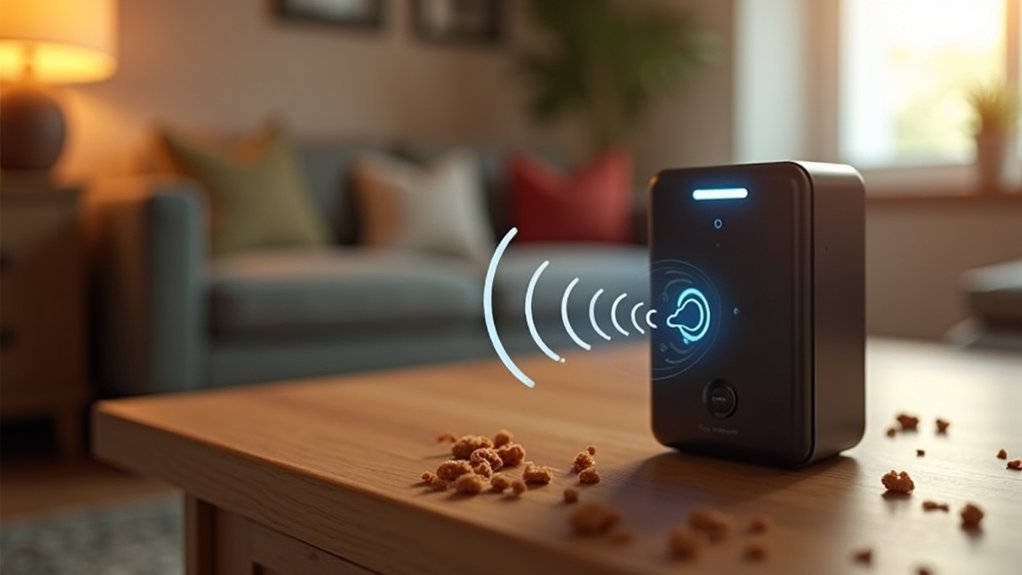Ultrasonic rodent repellers generally don’t deliver on their promises. Research shows rodents quickly adapt to the high-frequency sounds within 3-7 days, rendering these devices ineffective. Their limited range (20-30 feet) and inability to penetrate furniture or walls create “dead zones” where pests remain unaffected. You’ll likely see better results from traditional pest control methods like sealing entry points and removing food sources. The rest of this article reveals what pest control professionals actually recommend instead.
How Ultrasonic Rodent Repellers Claim to Work

Three key mechanisms underpin ultrasonic rodent repellers’ alleged effectiveness.
First, these devices emit sound waves at frequencies between 20-100 kHz—a range that’s supposedly inaudible to humans but distressing to rodents. You won’t hear anything, but your unwanted guests allegedly will.
Ultrasonic frequencies may fly under your radar, but they’re designed to create sonic chaos for your four-legged invaders.
Second, manufacturers claim these high-frequency sounds disrupt pests’ nervous systems, creating an uncomfortable environment that drives them away without causing physical harm. It’s marketed as a humane solution to your rodent problems.
Third, the constant ultrasonic output theoretically prevents rodents from adapting to their surroundings.
But do ultrasonic pest repellers really work? The science suggests otherwise. Many rodents show minimal response to these devices, with some adapting to the sounds over time.
Additionally, their limited range of 20-30 feet makes coverage questionable in larger spaces.
The Science Behind High-Frequency Sound and Rodent Behavior
Understanding the scientific basis for ultrasonic rodent repellers reveals why these devices often fail to deliver on their promises.
When you purchase high-frequency sound devices, you’re investing in technology that operates on questionable scientific principles.
- Rodents can hear frequencies between 20 kHz and 100 kHz that humans can’t detect.
- Initial exposure to these sounds may startle rodents, but they quickly adapt and return.
- Ultrasonic pest repellers have a limited range of only 20-30 feet, insufficient for larger spaces.
- Environmental barriers like furniture and walls block sound waves, creating “dead zones.”
- The presence of food sources often overrides any deterrent effect of the ultrasonic signals.
Without scientific evidence supporting their efficacy, these devices frequently disappoint homeowners seeking reliable pest control solutions, which explains why the FTC has flagged exaggerated manufacturer claims.
Research Studies on Ultrasonic Repeller Effectiveness

Although ultrasonic rodent repellers continue to sell well in hardware stores nationwide, scientific research consistently undermines their effectiveness. Multiple research studies conducted by military and independent organizations have failed to demonstrate that ultrasonic pest repellers produce significant reductions in rodent populations.
A prominent consumer magazine’s review bluntly concluded these devices are fundamentally ineffective, with manufacturers’ claims lacking substantial supporting evidence.
Scientific testing reveals that rodents typically adapt to the ultrasonic sounds over time, rendering any initial deterrent effects temporary at best.
Perhaps most telling, controlled studies have documented pest presence near active repellers, while consumer feedback frequently expresses disappointment with these products.
If you’re considering these devices, you should know that research overwhelmingly suggests your money might be better spent elsewhere.
Common Limitations of Ultrasonic Devices
The scientific research casting doubt on ultrasonic repellers is further validated when examining their inherent physical limitations.
Scientific evidence continues to undermine ultrasonic repellers, revealing fundamental physical constraints that limit their real-world effectiveness.
If you’re wondering whether ultrasonic pest repellers actually work, you’ll need to evaluate these significant constraints that reduce their effectiveness in real-world situations.
- Limited range of only 20-30 feet, making them inadequate for larger homes or buildings
- Environmental factors like humidity and background noise interfere with sound wave transmission
- Ultrasonic devices don’t address root causes like food sources or entry points
- Many rodents adapt to the sounds over time, diminishing long-term effectiveness
- Physical barriers (furniture, walls, corners) block ultrasonic waves, creating “sound shadows” where pests can safely remain
Why Rodents May Become Immune to Ultrasonic Signals

You’ll notice your ultrasonic repeller becoming less effective as rodents experience habituation, a process where they gradually stop responding to non-threatening stimuli.
Mice and rats possess remarkable adaptive survival mechanisms that allow them to thrive despite deterrents, often returning to areas once they determine the sound poses no real danger.
Environmental sonic interference, such as household appliances or ambient noise, can further mask ultrasonic signals, accelerating the rate at which rodents become desensitized to these devices.
Habituation Process Occurs
Despite manufacturers’ claims of long-term effectiveness, rodents gradually develop immunity to ultrasonic devices through a biological process called habituation.
This biological adaptation means your ultrasonic repellers become increasingly ineffective over time as rodents learn the sounds pose no real threat.
- Rodents’ brains recognize patterns in ultrasonic signals and eventually ignore them
- Environmental noises can accelerate the habituation process, especially in busy households
- Most rodents begin showing reduced responses to repellers within just 3-7 days
- Once habituation occurs, rodents will confidently return to their normal feeding and nesting behaviors
You’ll need to combine ultrasonic repellers with other pest control methods for effective results.
Understanding this habituation process explains why your seemingly perfect solution might work initially but fail to deliver lasting results.
Adaptive Survival Mechanisms
Evolution has equipped rodents with remarkable neurological survival mechanisms that explain their infamous resilience against ultrasonic repellers.
Your pest control strategy may fail because rodents’ highly adaptable nervous systems allow them to become desensitized to ultrasonic signals with repeated exposure.
When faced with continuous ultrasonic frequencies, mice and rats simply learn to tolerate what was initially disruptive. This adaptation happens faster in dense populations, where survival pressure accelerates their tolerance development.
Research demonstrates that some species even show increased survival rates in environments with ultrasonic pest repellers.
These adaptive survival mechanisms render many commercial devices ineffective over time. While you might notice temporary results when first installing a repeller, the biological reality remains: rodents evolve their behaviors in response to perceived threats, eventually nullifying the technology’s intended repellent effect.
Sonic Interference Issues
While ultrasonic repellers promise a humane solution to pest problems, physical limitations in sound transmission create significant barriers to their effectiveness. Sonic interference issues prevent ultrasonic repellers from working as advertised, leaving you wondering if ultrasonic repellers really deserve a place in your pest control arsenal.
- Background noise in your home can drown out repeller signals, rendering them useless.
- Objects like furniture and walls block ultrasonic waves, creating “safe zones” for rodents.
- The limited range (20-30 feet) means large areas remain unprotected.
- Rodents develop tolerance to consistent frequencies through desensitization.
- Multiple devices may create conflicting sound patterns that reduce overall effectiveness.
Despite manufacturers’ claims, these sonic barriers mean your clever rodent visitors may simply adapt to or avoid the ultrasonic deterrents rather than leaving your home.
Cost Analysis: Ultrasonic Devices vs. Traditional Methods
When comparing pest control options for your home, the financial implications deserve careful consideration. Ultrasonic repellers may seem like a bargain at $10-$100 compared to exterminators’ $100-$300 fees, but you might waste your money on ineffective technology.
| Cost Comparison | Ultrasonic Repellers | Traditional Methods |
|---|---|---|
| Initial Cost | $10-$100 | $20-$300 |
| Effectiveness | Limited/Questionable | Proven Results |
| Coverage | 20-30 feet per unit | Targeted Control |
| Long-term Value | Often Poor | Generally Good |
| Hidden Costs | Multiple units needed | Occasional replacement |
While ultrasonic devices offer lower upfront costs, their questionable performance often leads to additional expenses when homeowners eventually turn to traditional methods. Many consumers report better financial outcomes investing directly in proven solutions like traps that deliver immediate, reliable results.
Consumer Experiences and Real-World Results
You’ll find a stark contrast between manufacturers’ claims and actual consumer results with ultrasonic rodent repellers.
Despite marketing promises, many users report ongoing rodent problems even after installing these devices throughout their homes.
This reality gap highlights why scientific testing consistently shows these products fail to deliver the pest control effectiveness that companies advertise.
Users Report Mixed Results
Despite the enthusiastic marketing claims made by manufacturers, real-world experiences with ultrasonic rodent repellers tell a far more complex story.
The question of whether ultrasonic pest repellers actually work receives a resounding “maybe” from consumers who’ve tried them.
- Many users report no reduction in rodent activity despite months of use.
- A major magazine review concluded ultrasonic pest repellers really work poorly, if at all.
- Some consumers claim limited success in reducing rodent sightings.
- Traditional methods like cleaning and sealing entry points consistently outperform these devices.
- Most customers express frustration after investing in these products.
Your experience may vary, but the general consensus suggests saving your money and focusing on proven pest control methods instead of relying on these controversial devices.
Test vs. Reality Gap
The gulf between laboratory testing and real-world performance of ultrasonic rodent repellers continues to widen with each consumer review. You’ll find a stark contrast between manufacturer claims and what happens in your home.
| Claims vs. Reality | Manufacturer Claims | Consumer Experiences |
|---|---|---|
| Effectiveness | 100% pest removal | Minimal to no impact |
| Time to Results | Immediate | Indefinite waiting |
| Scientific Backing | “Military tested” | No credible evidence |
| Value for Money | Cost-effective | “Waste of money” |
| Additional Steps | None needed | Cleaning still required |
While some users report decreased rodent activity, many attribute success to improved cleanliness rather than the devices themselves. Scientific testing backs this skepticism, revealing no substantial evidence supporting their effectiveness. Before spending your money, consider that major publications have declared these products “essentially useless.”
Environmental Factors Affecting Repeller Performance
Why do ultrasonic rodent repellers sometimes fail to deliver the expected results? The effectiveness of ultrasonic repellers can be notably compromised by various environmental factors in your home. Understanding these limitations helps set realistic expectations for these devices.
- Temperature and humidity levels can degrade the sound waves’ intensity and range.
- Background noise from appliances or outdoor sources interferes with the ultrasonic frequencies.
- Physical layout limitations restrict effectiveness beyond 20-30 feet from the device.
- High rodent population density may overwhelm the repeller’s deterrent capabilities.
- Pest adaptation over time reduces long-term effectiveness, particularly when environmental conditions favor the pests.
For ideal results, you’ll need to take into account these environmental factors when placing your devices and possibly supplement with other pest control methods for thorough protection.
Better Alternatives for Rodent Control
While ultrasonic devices offer mixed results, physical traps provide reliable and immediate rodent control that you’ll find more consistently effective.
You can complement trapping methods with natural deterrents like peppermint oil or maintaining predator presence through a household cat.
Making environmental modifications, such as sealing entry points and eliminating food sources, will create a thorough approach that addresses the root causes of your rodent problem.
Traps Over Technology
Despite their high-tech appeal, ultrasonic rodent repellers often fall short when compared to traditional control methods. If you’re serious about eliminating rodent problems, consider tried-and-true trapping solutions instead of relying on questionable ultrasonic technology.
- Snap traps deliver immediate results while ultrasonic devices may only cause temporary disturbance.
- Humane traps provide an ethical alternative that’s more effective than ultrasonic repellers.
- Environmental modifications address root causes rather than just symptoms.
- Combining traps with preventive measures creates a thorough control strategy.
- Expert consensus favors physical trapping methods over sound-based deterrents.
When facing a rodent infestation, your money is better spent on proven solutions. Traditional traps, whether snap or humane varieties, consistently outperform ultrasonic alternatives in real-world testing and provide more reliable, long-lasting results.
Natural Deterrent Methods
Instead of wasting money on ineffective ultrasonic devices, you’ll find numerous natural solutions that actually work to keep rodents at bay. Strong scents like peppermint oil, cayenne pepper, and vinegar serve as powerful natural deterrents that mice and rats actively avoid.
For effective pest prevention, focus on eliminating what attracts rodents in the first place. Keep all food tightly sealed and clean up crumbs immediately.
Seal entry points around your home’s foundation, walls, and utility lines to physically block their access.
Consider enlisting nature’s own rodent controllers—cats make excellent deterrents even when they’re not actively hunting. Creating habitat for owls near your property can also help manage outdoor rodent populations naturally.
These methods don’t just repel rodents temporarily; they create an environment that’s consistently unwelcoming to unwanted pests.
DIY Rodent Exclusion Techniques That Actually Work
Because rodents can infiltrate your home through the tiniest openings, effective DIY exclusion techniques focus on eliminating entry points and removing attractants.
While ultrasonic pest repellers claim to solve infestations electronically, these proven manual methods deliver reliable results.
- Seal all entry points larger than a quarter-inch using caulk or steel wool, as mice can squeeze through surprisingly small gaps.
- Install door sweeps and repair damaged window screens to block common access routes.
- Store food in airtight containers and clean up crumbs promptly to eliminate attractants.
- Place snap or humane traps in high-traffic areas where you’ve noticed droppings.
- Remove potential nesting materials by decluttering spaces and disposing of cardboard boxes and old newspapers.
These hands-on techniques create a thorough defense system that’s more effective than relying solely on electronic pest repellers.
Combining Methods for Maximum Rodent Protection
While ultrasonic repellers alone often fall short of expectations, they can serve as valuable components in a thorough rodent control strategy.
Combining methods creates a multi-layered defense that addresses both immediate infestations and prevents future ones.
Layered pest control tactics create robust protection against current infestations while establishing barriers against future rodent problems.
For maximum protection, pair your ultrasonic repellers with traditional traps and environmental modifications.
Seal entry points, eliminate food sources, and use natural deterrents alongside your ultrasonic devices to create a truly inhospitable environment for rodents.
Remember that ultrasonic effectiveness diminishes over time as rodents acclimate to the sounds.
By implementing a diverse approach, you’ll overcome the limitations of any single method.
Monitor your combined strategy regularly, adjusting tactics as needed to maintain effectiveness.
This integrated pest management approach delivers substantially better results than relying on ultrasonic technology alone.
What Pest Control Professionals Really Think
This integrated approach to rodent control aligns with what industry experts have observed for years.
If you’ve wondered what pest control professionals really think about ultrasonic repellers, their assessment is largely cautious.
- Most professionals express skepticism about ultrasonic repellers as standalone solutions.
- The FTC has issued warnings to manufacturers about making unsubstantiated efficacy claims.
- Experts note that rodents often adapt to ultrasonic frequencies, reducing effectiveness over time.
- The limited range (20-30 feet) of these devices makes them inadequate for larger spaces.
- Pest control veterans recommend combining ultrasonic technology with traditional methods.
While ultrasonic repellers might offer some initial deterrent effect, you’ll find most professionals view them as supplementary tools rather than replacements for thorough pest management strategies that address entry points, food sources, and nesting areas.
Frequently Asked Questions
Is There Any Evidence That Ultrasonic Pest Repellers Work?
Scientific studies don’t support ultrasonic pest repellers’ effectiveness. You’ll find little credible evidence they work, and many pests adapt to the sounds over time. The FTC has even warned manufacturers about making unsupported claims.
Do Ultrasonic Devices Really Repel Rodents?
Ultrasonic devices don’t reliably repel rodents. Scientific evidence doesn’t support manufacturers’ claims, and you’ll likely waste your money. Rodents typically adapt to the sounds quickly, making these devices ineffective for long-term pest control.
What Are the Disadvantages of Ultrasonic Pest Repellers?
You’ll face several drawbacks with ultrasonic pest repellers: limited range (20-30 feet), ineffectiveness against many pests, rodent adaptation over time, potential interference with electronic devices, and questionable long-term results despite manufacturer claims.
What Is the Most Effective Rodent Deterrent?
The most effective rodent deterrent is an integrated approach. You’ll need to seal entry points, eliminate food sources, and use snap traps or bait stations. Don’t rely on a single method for complete control.
In Summary
You’re better off investing in proven rodent control methods rather than ultrasonic repellers. While these devices sound promising, scientific research doesn’t support their effectiveness. Rodents quickly adapt to the sounds and continue their invasive behaviors. Instead, focus on sealing entry points, removing food sources, and using traditional traps or professional pest control services. Combining these practical approaches will give you notably better results than relying on sonic gadgetry alone.





Leave a Reply